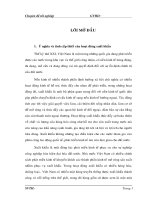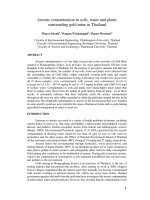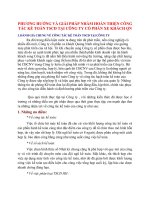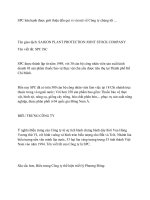QN thermal plant
Bạn đang xem bản rút gọn của tài liệu. Xem và tải ngay bản đầy đủ của tài liệu tại đây (1.01 MB, 27 trang )
Environmental Impact Assessment of
Prepared
Preparedby:
by:
NGUYEN THE VINH
ContentS
Introduction
Project description
Existing of environment at Project site
Existing of environment in Project area
Impact assessment of project
Mitigation measures of impacts
Conclusions and recommendations
Halong Bay is a natural heritage
acknowledged by UNESCO.
Energy
resources
are
under the big pressure
from economic growth.
Quangninh thermal power
plant is within the scope
of the national power
energy
development
program.
Determine, analyze and forecast
all impacts of QN thermal power
plant during construction stage.
Determine and analyze impacts in
operation stage
Recommend mitigation measures
for human living and
environmental protection.
MAJOR PARAMETERS AND APPLICABLE TECHNOLOGY
Parameters
Plant capacity
: 1200 MW
Boiler type :
PC
Unit capacity
: 300 MW
Boiler efficiency : > 89 %
Turbine - generator efficiency
: > 44 %
Other losses
: 0.5 %
Plant efficiency
: 39 %
Operation hours : 6000 hrs
Air temperature
: 24 oC
Fuel consumption rate
: 0.471 kg/kwh
Plant fuel consumption
: 565 t/h
Unburned carbon in ash
:6%
Unburned carbon in coal : 2.30 %
MAJOR PARAMETERS AND APPLICABLE TECHNOLOGY
Fuel
Carbon
C
%
49.50
Hydrogen
H
%
2.93
Oxygen
O2
%
1.93
Nitrogen
N
%
1.04
Sulphur
S
%
0.6
Ash content
Ap
%
36
Humidity
Wp
%
8.00
V
%
6.50
Low heating value
LHV
Kcal/kg
4655
High heating value
HHV
Kcal/kg
4860
Volatile matter
Checklist: for identification of effect
and impact of project
Statistic method: collect and solve socioeconomic, hydro-meteo data
Comparison method: analyze impact on the
basic VN’s standards(1995,2001)
Rapid assessment: suggested by WHO
Assessment of pollution load
Assessment of measures for pollution control
Frame work of
Methodology
QN Thermal Power Plant
Construction phase
Operation phase
Pollutants
Pollutants
Located Project
Soil
Air
Water
Compare
Environmental
Impact
Assessment
Socio-Economic
Mitigation Measures
Eco-System
Conclusions
Vietnamese
standards
Project description
Quảng ninh
Thermal Plant
Location coordinate:
+ 1070 05’20’’ to 11027’17’’ north latitude
+ 21002’10’’ to 109001’00’’ east longitude
Project description
The owner: Electricity
of Vietnam
The location: at Thong
Nhat commune, Hoanh
Bo district, Quang Ninh
province
The whole area:
100 ha
The NPP’s capacity: 1200 MW (4x300MW)
The fuels is transported by conveytor in direction
The physical environment
Topography
Mainland topography
Surrounded by low
sloping hill
Areolation
Seabed topography
Crushed primitive
sediments
Meteorology
Climate and weather
Wind
Rain
Storm
June to October
Humidity
Average year : 80%
Solar radiation
2430 -2600 h/year
Average weather data during 10 years (1991 - 2001)
Parameters
Average data
Annual average temperature
23 0C
Annual average of maximum temperature
26.6 0C
Annual temperature of minimum temperature
20.2 0C
Highest temperature
40.5 0C
Lowest temperature
5 0C
Annual average rainfall
1912 mm
Monthly highest average rainfall
390.9 mm (June)
Monthly lowest average rainfall
28.1 mm (January)
Annual average rainy days
140 days
Hydrogeology
Tidal regime; High:3.6m,
Aver: 2.06 m, ebb:0.5m
Vibration of cycle regime of
sea water: stable
Ware: Smooth, 0.25m
Temperature of sea water
aver 16.8- 28.6 0C
Salinity of sea water
Soil quality
aver: 0.42%
Soft, hard clay
Freshwater
Clay- sand
Suspended waste solid
The biological environment
Tidal ecosystem (
species)
Sub-tidal ecosystem
Shallow water: 3 species
Sea grass: 71, 40(mollusks)
Coral: 117 species, 40 genera, 12
families
Tidal ecosystem
Mangrove forest: 13 species
Terrestrial ecosystem
Mammal: 35 species, 15 genus,
8 register
Bird: 14 species
Reptile: 7 species
Hermaphrodism: 2 species
Aquatics ecosystem
Algae:
100 species belong 3 major
genus
Zooplankton:
50 species belonged 11 descent
Benthic animal:
8 species
Seafood:
30 species of shrimp, 14 of crab
and mollusks
Fish:
Many species of fish.
Data of diversity in Bai Chay gulf and Ha Long bay.
Location
Density
(Individual)
Living
mass
(g/m2)
Species
number
Species
diversity
factor (H)
Stability
factor (J)
A
46.67
10.17
7
1.80
0.93
B
47.50
15.00
11
2.27
0.95
C
90.00
25.67
9
2.03
0.93
D
48.33
12.00
14
2.44
0.92
E
50.00
42.67
9
2.08
0.95
Density of living and benthic animals at Ha Long and Bai Chay gulf.
(Values in bracket is percentage rate at such locations.)
Annelida
Crab
Mollusks
Individual/m2
g/m2
Individual/
m2
g/m2
Individual /m2
G/m2
3
(6.51)
0.17
(1.67)
--
--
43
(93.49)
10.00
(98.33)
28
(58.33)
3.00
(20.00)
--
--
20
(41.67)
12.00
(80)
--
--
17
(50.00)
17.34
(68.00)
17
(50.00)
8.33
(32.00)
12
(24.49)
1.16
(9.66)
7
(14.29)
3.33
(27.75)
30
(61.22)
7.51
(62.59)
7
(13.73)
1.00
(2.34)
17
(33.33)
16.33
(38.27)
27
(52.94)
25.34
(59.39)
8
(11.27)
1.50
(2.28)
18
(25.35)
23.00
(34.98)
45
(63.38)
41.25
(62.74)
The socio-economic situation
Population
Land use structure
5,261 people/1,338 household in
Hakhanh precinct
7,945 people/1,800 household in
Thong nhat Commune
31.53km2, 238ha of arable, 336 ha
of industry and 988 ha of forests
Infrastructure
Education and training
1 primary (HK) and 9 school (TN)
Medical station: 1(HK) and 1(TN)
Transportation
Public health
Fresh water system, medical care
Existing environment at project
area
Existing water quality
Air environment quality
Surface water environment
Result of analyzing of water samples
Air environmental pollution source
Result of analyzing of air samples
Noise status
Noise generation source
Results of analyzing of noise samples
Almost all pollution indices are within permissible
limit of VN’s standard
Soil :Lead, copper, zinc content is higher than other
areas
Construction phase
Pollution sources
Pollution with solid wastes
Dust, water, noise, thermal, working activities
Impact on the water quality
From 500 workers, employees
Impact on air quality
From vehicles, transportation vehicles,
equipments, earthwork activities..
Air pollutants, toxic gas..
Waste construction material: brick, pebbles,
cements, woods, metals
Other impact
Pille driving (vibration), temporary constructions,
noise pollutants…
Operation phase
Impact on the atmosphere
Impact on the tidal ecosystem
Impact on the aquatic ecosystem
Impact on soil and sediment
Impact on biodiversity
Impact on people
Potential of malignant growth
Diseases and respiration system
Thyroid gland…
Congenital malformation, Intestinal diseases,
memory reduction in children
During construction phase
Aquatic ecosystem
temporary treatment, oil water separator, minimum
wastes..
Air impact
regulations, management/control of domestic traffic,
monitoring toxic gas, …
Control of pollution caused by construction
plant and equipments
Prevention of the use of obsolete, overload machinery, etc.
Control of pollution caused by solid waste
Mitigation measure of other impact
take care of health workers, safety and security measure
to avoid accident, destroying forest, etc.
Operation of TPP
Mitigation impact on air quality
Control measure for toxic gases
dispersion
Dusts, SO2, , NOx..
Mitigation measures for impact
on water quality
Waste water, oil wastes treatment
Treatment of solid wastes, wastes..
Noise and vibration control
Power supply system
Lightning and earthing system
Environment monitoring
program
Management measure for local environment
protection
Environment protection group.
Environmental training course
Health care
Monitoring program
Environment pollution monitoring
During construction phase
Pollution control program
Accident analysis
Public information
Quang ninh TPP is expected to be an
important option of energy for the
achievement of socio-economic development
and environmental protection
Annually, the plant supplies about
7,200TWh for national economy.
Quang Ninh TPP project will create job
opportunities for thousands of people
Create favorable conditions for the
development of the regional economy and
attraction of foreign investment in this
area,.. etc.









